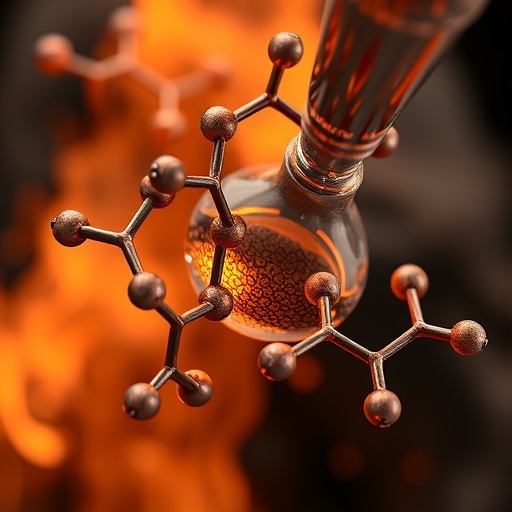In a groundbreaking study that promises to reshape the landscape of organic synthesis, a research team led by Jiang et al. has unveiled an innovative approach to the synthesis of carbazole-based di- and triarylmethanes using iron as a catalyst. The work, which appears in the esteemed journal ‘Molecular Diversity’, highlights the efficacy of employing iron—a cheaper and more environmentally friendly alternative compared to traditional precious metal catalysts—in complex organic reactions. This work is not only a testament to the versatility of iron in catalysis but marks a significant step toward sustainable practices in chemical manufacturing.
In the realm of organic chemistry, carbazoles and their derivatives have long held prominent positions due to their diverse applications, ranging from pharmaceuticals to organic light-emitting diodes. The challenge in synthesizing these compounds lies in the need for selective reactions that can produce various derivatives without generating unwanted by-products. Jiang and his team have developed a method that allows for the creation of both di- and triarylmethanes in a single catalytic process, a feature that could expedite production timelines in chemical research and industrial applications alike.
The synthesis process described in the paper employs a straightforward yet powerful iron-catalyzed reaction that initiates a coupling reaction between various aryl halides and carbazole derivatives. At the heart of this research is the ingenious design of the reaction conditions, which include specific temperature and solvent systems that facilitate high yields of the desired products. The team’s innovation hinges on the manipulation of these parameters to fine-tune the selectivity towards di- or triarylmethane results, effectively expanding the toolkit available for synthetic chemists.
Not only does the team report success in the synthesis of carbazole-based compounds through this method, but they also provide detailed mechanistic insights into the reaction pathways involved. Utilizing advanced techniques such as NMR spectroscopy and mass spectrometry, the researchers tracked the reaction intermediates and characterized the electron transfer mechanisms that drive the formation of the final products. This level of detail not only elucidates the reaction mechanisms but also lays a foundation for future research into optimizing these interactions further.
What sets this research apart from previous methodologies is not only the versatility in product formation but also the well-established safety profile of iron compared to more toxic catalysts. Precious metals like palladium and platinum, traditionally used in such reactions, pose significant regulatory and environmental challenges. The shift to iron catalysis represents a significant stride towards sustainability in organic synthesis. Jiang’s research embodies the principle that chemists can innovate without compromising the environment or public health—an increasingly vital consideration in today’s climate-conscious landscape.
Furthermore, the researchers emphasize the ease with which their method can be replicated and adapted. With only a few specific reagents required and a relatively simple lab setup, this iron-catalyzed protocol could democratize access to advanced synthetic techniques, enabling even smaller research labs and institutions to conduct high-level organic synthesis. This democratization of technology could spark a wave of innovation across the scientific community, inspiring new applications of carbazole derivatives that had not previously been pursued.
In the discussions that follow the research findings, Jiang and co-authors specify the broader implications of their work. Carbazoles have established applications in materials science and electronics, particularly in the development of high-performance organic semiconductors. The newly synthesized di- and triarylmethanes could lead to advancements in the efficiency and stability of these electronic materials, amplifying their use in next-generation technologies such as flexible electronics and energy-harvesting devices.
Another exciting aspect of this research is the potential for further modifications and adaptations of the synthesized carbazole derivatives. The authors speculate that by tweaking the synthesis conditions or introducing different substituents into the reaction, it might be possible to create a plethora of novel compounds. This opens the door for exploration into new medicinal applications, as the bioactivity of carbazole derivatives has been heavily studied, with a number of them exhibiting significant pharmaceutical potentials.
As the world grapples with pressing challenges in sustainability, including the climate crisis and the depletion of natural resources, the move towards using abundant and less harmful materials in chemical synthesis is a welcome trend. The chemists involved in this study exemplify that innovation does not have to come at the expense of safety or environmental stewardship. By leveraging resources like iron, the research community moves one step closer to sustainable chemistry practices that respect both human health and the planet’s resources.
The response from the scientific community to Jiang et al.’s findings has been overwhelmingly positive. Social media platforms and academic networks have buzzed with discussions about the impact of these results on future research directions. Early adopters of this method report promising initial results, and collaborative efforts are already underway to further build on the findings. Researchers believe the full potential of carbazole derivatives in various applications will take shape rapidly as this relatively simple reaction garners more attention.
As this study attracts more interest, it underlines a critical point: the synthesis of complex organic molecules may not always require intricate and elaborate techniques. With rediscovery of simpler catalysts like iron, chemists can focus on cleaner, faster, and more economical pathways toward producing valuable compounds. This could lead to significant shifts in how chemical research is conducted, prioritizing efficiency and environmental care.
In conclusion, the groundbreaking work by Jiang and his colleagues not only serves as a beacon of innovation in the field of organic synthesis but also challenges existing paradigms regarding catalytic processes. By successfully utilizing iron to synthesize carbazole-based di- and triarylmethanes, the researchers have paved the way for future studies that intersect sustainability with synthetic chemistry. As the study spreads throughout academic and industrial circles, it is poised to impact the global approach to chemical synthesis in meaningful ways.
Whether in pharmaceutical research, materials science, or environmental applications, the implications of this method are vast and compelling. With a growing emphasis on sustainable practices and a shift towards more accessible and less toxic reagents, Jiang et al.’s research is sure to inspire a new wave of creativity and responsibility in organic chemistry. As scientists and researchers across the globe begin to adopt these innovative approaches, the future of chemical synthesis looks not only efficient but fundamentally aligned with the principles of sustainability that are critical in today’s world.
Subject of Research:
Iron-catalyzed synthesis of carbazole-based di- and triarylmethanes.
Article Title:
Iron‑catalyzed divergent synthesis of carbazole-based di- and triarylmethanes.
Article References:
Jiang, YJ., Hu, HL., Niu, YD. et al. Iron‑catalyzed divergent synthesis of carbazole-based di-/triarylmethanes.
Mol Divers (2025). https://doi.org/10.1007/s11030-025-11286-4
Image Credits:
AI Generated
DOI:
Keywords:
Iron catalysis, carbazole derivatives, organic synthesis, sustainability, diarylmethanes, triarylmethanes.
Tags: carbazole derivativeschemical manufacturing practicesdi- and triarylmethanesenvironmentally friendly catalystsinnovative synthesis methodsiron-catalyzed synthesisJiang et al. researchorganic light-emitting diodespharmaceuticals and carbazolesselective chemical reactionssustainable organic chemistryversatile catalysts in organic reactions





